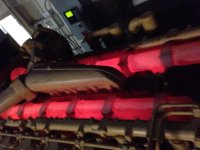May not even be a back room deal... Many government sites want to show they are ahead of the emission rules and going beyond because they are so progressive.
I think I mentioned that around here they spent almost as much on add on aftermarket after treatment systems on new generators as the generators themselves when it wasn’t required for their application. This on a site where they are extremely unlikely to run more than 14 hrs a year. On the operation and maintenance side they will add about 60% to the operating cost even if nothing fails. They keep about 750gal of DEF on site that has a shelf life of roughly a year and has to be disposed of and replaced.
After treatment is almost the new snake oil (only difference is the results can be tested and proven). It can be done right but should be properly integrated with the engine and will never have the reliability of the bare engine.
More and more small after treatment companies are popping up and putting the squeeze on public utilities and governments in particular since if they say no, they can go public and say “this or that public agency doesn’t care about your air”.
The same thing happened about 20 years ago with fuel polishing... A couple fuel polishing companies popped up and hit the government sites and large commercial buildings. If government sites said no, they wrote letters to the editor and contacted reporters who wrote newspaper articles, I remember one front page headline saying “80% of emergency generators may not start”. In 25 years I’ve seen two diesel gensets that wouldn’t start because of old fuel. Most actual fail to start conditions were and still are battery related for diesels. Nat gas and propane have more fuel related no start issues than battery.
I guess that’s another rant done.
To answer the actual question at hand, raise the exhaust above the roofline with sched 40 pipe is the proper solution and should have been done when it was installed. For 35’ there will need to be an expansion joint and hangers that allow movement but shouldn’t cost anywhere near $100k. I’d guess about $20k for a mechanical contractor, double that for a generator company to farm it out to the same mechanical contractor.
